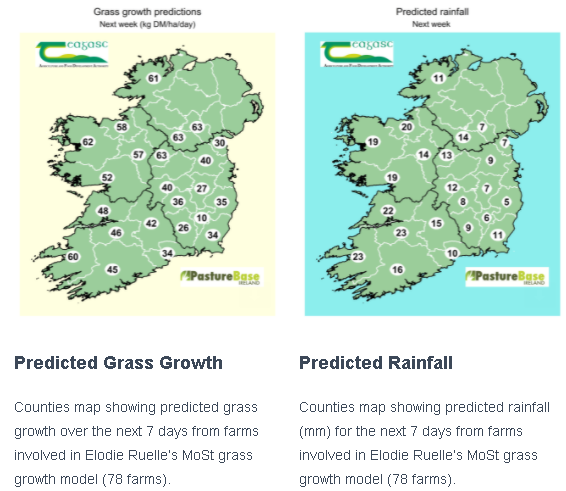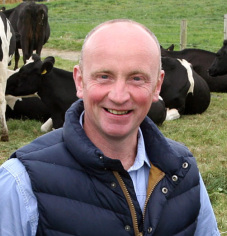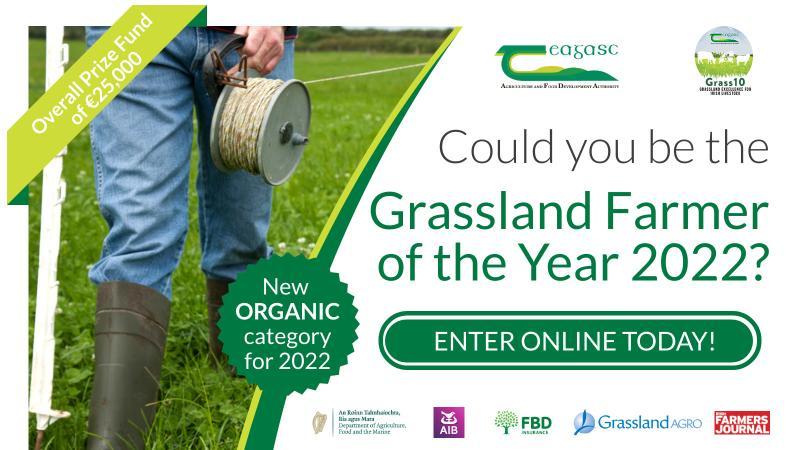24 August 2022
Grass10 Newsletter – 23rd August 2021

The Grass10 team has an action-packed newsletter this week. From Grassland Farmer competition to featured farmers, clover reporter and dairy & beef podcasts to the upcoming GFOTY Farm Walks and Swards for the Future Conference/Workshop. Plus the regular features and advice on Autumn grass management
210th Edition – 23rd August 2022




Grass10 Weekly Tips
Soil moisture deficits widespread, grass growth severely restricted
For many farms around the country, low rainfall has led to soil moisture deficits developing. SMDs are varying depending on rainfall in your area. Where SMDs are >50mm (i.e. 50mm rain required to get back to soil saturation), grass growth is severely restricted. This is the case for many farms and more will join this category as low rainfall is forecast.
High SMD > 50mm – where drought conditions persist
Continue with low daily grass demand.
Try and hold grass cover on the farm, continue with sufficient supplement. For Beef farms, the options to reduce demand are: house finishing cattle, feed meal outside, feed silage outside, other feeds/forages, sell some animals.
Grass DM is higher during drought periods (>20% DM) and grass supply tends to be underestimated.
Post grazing residuals of 4 to 4.5cm should be maintained, don’t waste feed.
Continue to hold off N fertilisation if grass growth is <35kg DM/ha or the grass base is brown
Keep AFC cover >500 kg/ha. Dropping AFC will reduce the farm overall growth rate.
Maintain rotation length at 30 days approximately. This means grazing no more 4% of the grazing platform daily.
Visibly drought stressed covers should be grazed this week to allow recovery after rain.
In the rain period post drought, soil N is released, don’t over fertilise, maintain fertilizer N at ±15-20kg per ha after grazing if average growth >45kg.
In areas that have received some rain
Slowly increase grass allowance and build AFC
Hold/Increase grazing rotation to 35 days
Maintain post grazing residuals of 4 to 4.5cm, don’t waste feed.
In paddocks with visibly drought stressed covers, graze immediately to allow recovery
In the recovery period post drought, maintain fertilizer N at ±15-20kg per ha after grazing if average growth >45kg.
Reduce supplement once growth exceeds grass demand.
Other areas of the country that have received adequate rainfall, keep in line with Autumn Targets below and take out a paddock for surplus bales if you are 100 kg DM/Ha ahead of your AFC targets.
Review soil samples and apply Lime and P & K this Autumn
In the soil fertility trends below, national soil fertility is decreasing slightly on dairy farms. Now is the time to look at soil samples and apply Lime as ground conditions are excellent. Remember you only need to get 10 acres together to have sufficient area for 1 lorry load of lime (20 tonne).
Also review PastureBase and assess how many grazings and silage cuts have been taken off your paddocks. Calculate how much P and K has been applied this year in the form of slurry and fertiliser and apply P and K to paddocks that require it for maintenance. William Burchill discusses the P and K nutrients that are taken off by both silage and grazing which will help you calculate your requirements.
Review your AFC with Autumn Targets for your farm
Keep an eye on the Autumn Grazing Targets for your farm in the table below. Farms stocked around 2.5-3.0 LU/ha should begin building grass in the next week. Keep walking your farm weekly to monitor AFC against the targets. Rotation length should be 25 days for farms stocked at 3.0+ LU/ha. This is not rotation length between grazing events, it is rotation length based on area per day. E.g. 25ha grazing block should be grazing 1 ha per day, this should extend to 30 days by early Sept, i.e. 0.8 ha per day.
1st Sept targets for different levels of stocking rate-:
2.5 LU/Ha – 750 Kg DM/Ha AFC
3.0 LU/Ha – 990 Kg DM/Ha AFC
3.5 LU/Ha – 980 Kg DM/Ha AFC
Enter the 2022 Grassland Farmer of the Year Competition!
This year’s Grassland Farmer of the Year competition has been launched. The competition recognises and acknowledges those dairy, beef and sheep farmers who are achieving high levels of grass utilisation in a sustainable manner. This year’s competition has 7 different categories for you to enter-:
Dairy
Drystock
Clover/Sustainable farming
Heavy soils/Disadvantaged Land
Innovation
Young Farmer (under 30 years)*
Organic Farmer
Click on the link below for more information and to enter. Good luck!
Click here to enter the 2022 Grassland Farmer of the Year Competition!
Autumn Grazing Targets

Grass10 Featured Farmers
In this weeks newsletter we hear from two featured farmers. Patrick O Neill in Co. Longford who has recieved adequate rainfall and is building grass covers on his farm.
We also hear from John Phelan, Carriganure, Co. Waterford who has being suffering with drought for a number of weeks & silage in the diet since June.
Variation is the order of the day throughout the country depending on the rainfall that you have received.
Patrick O Neill, Mostrim, Co. Longford
 Patrick O Neill, in partnership with his father Tom, milks 120 cows in Co. Longford alongside his wife Michelle & 4 children ( Paidi, Sean and twins Aisling and Darragh)
Patrick O Neill, in partnership with his father Tom, milks 120 cows in Co. Longford alongside his wife Michelle & 4 children ( Paidi, Sean and twins Aisling and Darragh)
Patrick updates us on his current grazing situation as he builds grass for the Autumn.
John Phelan, Co. Waterford
 “We have been in a drough for a large part of the summer here in Co. Waterford.
“We have been in a drough for a large part of the summer here in Co. Waterford.
We are feeding silage since the middle of June (around 10-14 days where silage was not fed during this period)
Paddocks are set up for three grazings per paddock when at a cover of 1,500kg DM/ha, so it allocating one third of the paddock at each grazing and filling the deficit with concentrate and silage
Currently feeding 5kg concentrate and 5kg silage
All surplus bales and last year’s bales are eaten
Currently eating first cut – luckily silage quality is good
Large workload is making the farm a lot harder to manage
This year feels worse than 2018 as rain to build autumn covers has not arrived”
My PastureBase figures are as follows-:
Average Farm Cover 432 Kg DM/Ha
Cover/LU 107 Kg DM/Ha
Growth 25 Kg DM/Ha
Demand 28 Kg Dm/Ha
Diet- 7kg Grass, 5Kg Meal and 5kg Silage

Aidan Maguire is deservedly the 2021 Drystock Grassland Farmer of the Year. The progress this farmer has made in such a short space of time is phenomenal.
He joined his local Grass10 group on advice of local advisor and the Dairy-calf to beef programme three years ago. Aidan is the focus farmer for the Grass10 group. He started measuring grass then and went on a steep learning curve to changing how he viewed grass in his farming system.Join the Teagasc Grass10 team along with the Teagasc DairyBeef500 team on the evening of 31 August at 6.30pm on the farm of Aidan Maguire, Navan, Co. Meath for his farm walk.
Click here to watch Aidan’s promo video
National Soil Fertility Trends

Soil fertility declining on Irish dairy farms
In 2021 Teagasc analysed a total 33,876 soil samples comprising of dairy, drystock and tillage enterprises. Overall soil samples number increased by 13% in 2021.
There was 30,082 grassland soil samples. Of which 21,049 was taken on dairy farms which represents an increase of 11% compared to 2020
The following is a summary of the main changes for soil pH, phosphorus (P) and potassium (K) in 2021 on dairy farms.
Dairy
16% of soils have optimum pH, P & K (3 % decrease)
53% of soils with a soil pH >6.2 (10% decrease)
55% of soils at P index 1 & 2 (4% Increase)
48% of soils at K Index 1 & 2 (no change)
2021 shows that soil fertility declines on dairy farms for the second consecutive year. This is mainly driven by a decrease in soil pH and P levels. Soil K levels have remained stable in 2021. This trend could be the result of a new soil sampling cycle on farms plus the drive to maximise grass production on specific areas of the farm (grazing block). With escalated fertilisers prices for the coming season we should aim to at least maintain soil fertility levels and halt this emerging decline. Soil fertility is a key driver of N efficiency on farms and reducing emissions from agricultural soils.
Now is a good time to take fresh soil samples especially on farms that applied less P and K fertiliser in 2021 and assess its impact on farm soil fertility levels. Low cost technologies such as applying lime and optimising soil pH is a must and needs to be addressed over the coming weeks and months as it is key to driving N use efficiency on farm especially with record high N costs currently.
Take action now
Assess field P & K balances
Take fresh soil samples
Apply lime over the coming weeks
Update farm fertiliser plan
Plan fertiliser requirements for 2023
Click here to read full soil fertility report

The Dairy Edge Podcast with GFOY Overall Winner Colin Doherty
 In this weeks Dairy Edge podcast,Grass10 Champion, Colin Doherty speaks to Emma-Louise on building a repeatable grass-based system ahead of his farm walk on 6th September (see advert below)
In this weeks Dairy Edge podcast,Grass10 Champion, Colin Doherty speaks to Emma-Louise on building a repeatable grass-based system ahead of his farm walk on 6th September (see advert below)


 Jim White, Co. Tipperary
Jim White, Co. Tipperary
This section will give weekly reports and videos from farmers who have a lot of clover established on their farms.
This week, we hear from dairy farmer, Jim White from Co. Tipperary who updates us on his autumn plans for his grass clover swards
Managing Grass for the Autumn on Beef farms

With parts of the country in drought & some rain arriving, Joseph Dunphy Teagasc Grass10 advisor and Fergal Maguire DairyBeef500 advisor are on this week’s Beef Edge podcast with advice & tips in advance of the last rotation. Click below
Swards For The Future Conference

Click here for more information and to Register
Sign up for weekly grass 10 newsletter



